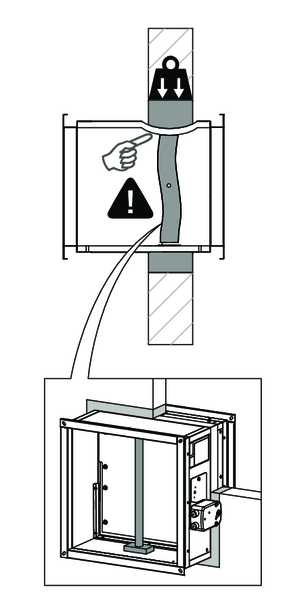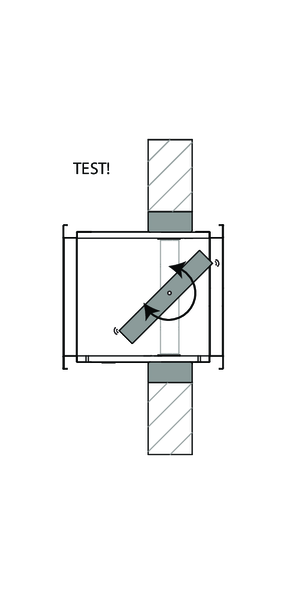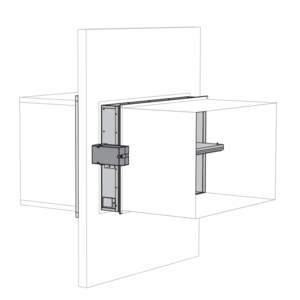- Home
- Products
- Smoke control dampers
- VUW120
- Installation
VUW120 - Installation
Installation at a minimal distance from another smoke control damper or from an adjacent wall/floor
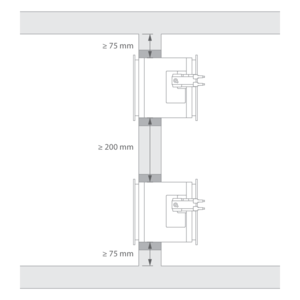
European test standard EN 1366-10 specifies the minimum required distance between 2 smoke control dampers and between a smoke control damper and a supporting construction when applied at a compartment boundary (wall mounted classification):
- 200 mm between 2 smoke control dampers (measured from damper tunnel to damper tunnel, without taking the connecting flanges into account)
- 75 mm between a smoke control damper and a supporting construction (measured from the damper tunnel, without taking the connection flanges into account)
Installation in rigid wall
The product was tested and approved in:
- Aerated concrete ≥ 100 mm | EI 120 (vew i o) S 1500 AA multi C10000 | Mortar | Type of installation: built-in 0/180° | 300x300 mm ≤ VUW120 ≤ 1500x1000 mm
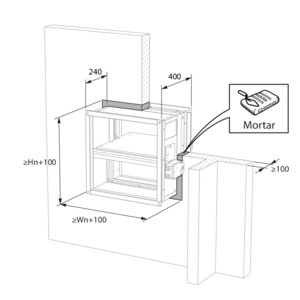
Make the necessary openings ≤ (Wn + 100 mm) x (Hn + 100 mm) in the wall.
Mount the damper in the opening.
Seal the rest of the opening with standard mortar.
Mount the damper in the opening.
Seal the rest of the opening with standard mortar.
Installation in a multi / single compartment application
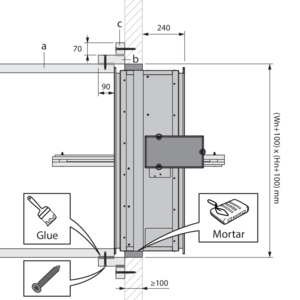
On the multi-compartment side:
Connect the damper to a smoke control duct, tested according to EN 1366-8, with a classification of EI120S -1500/+500Pa.
Example: Promatect L500 ≥ 50 mm Duct adhesive: Promat K84 Screws: ø5x90 with thread
Place the smoke control duct (a) against the flange of the damper. A frame (b), made of the same material, connects the duct to the wall. This frame has an overlap on the duct of at least 90 mm. Fix the frame to the duct using screws (ø5x90 mm) every 150 mm and matching duct glue. A second frame (c) 70 mm high, made of the same duct material, is screwed to the wall with screws suitable for that application.
Other possible types of smoke control ducts (list not exhaustive): - Geotec - Geoflam (Light) - System with steel ducts - ...
Connect the damper to a smoke control duct, tested according to EN 1366-8, with a classification of EI120S -1500/+500Pa.
Example: Promatect L500 ≥ 50 mm Duct adhesive: Promat K84 Screws: ø5x90 with thread
Place the smoke control duct (a) against the flange of the damper. A frame (b), made of the same material, connects the duct to the wall. This frame has an overlap on the duct of at least 90 mm. Fix the frame to the duct using screws (ø5x90 mm) every 150 mm and matching duct glue. A second frame (c) 70 mm high, made of the same duct material, is screwed to the wall with screws suitable for that application.
Other possible types of smoke control ducts (list not exhaustive): - Geotec - Geoflam (Light) - System with steel ducts - ...
Installation with multi compartment application on both sides
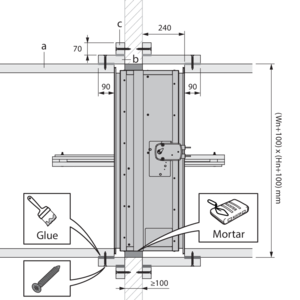
Connect the damper to a smoke control duct on both sides, tested according to EN 1366-8, with a classification of EI120S -1500/+500Pa.
Example: Promatect L500 ≥ 50 mm Duct adhesive: Promat K84 Screws: ø5x90 with thread
Place the smoke control duct (a) against the flange of the damper. A frame (b), made of the same material, connects the duct to the wall. This frame has an overlap on the duct of at least 90 mm. Fix the frame to the duct using screws (ø5x90 mm) every 150 mm and matching duct glue. A second frame (c) 70 mm high, made of the same duct material, is screwed to the wall with screws suitable for that application.
Other possible types of smoke control ducts (list not exhaustive): - Geotec - Geoflam (Light) - System with steel ducts - ...
Example: Promatect L500 ≥ 50 mm Duct adhesive: Promat K84 Screws: ø5x90 with thread
Place the smoke control duct (a) against the flange of the damper. A frame (b), made of the same material, connects the duct to the wall. This frame has an overlap on the duct of at least 90 mm. Fix the frame to the duct using screws (ø5x90 mm) every 150 mm and matching duct glue. A second frame (c) 70 mm high, made of the same duct material, is screwed to the wall with screws suitable for that application.
Other possible types of smoke control ducts (list not exhaustive): - Geotec - Geoflam (Light) - System with steel ducts - ...
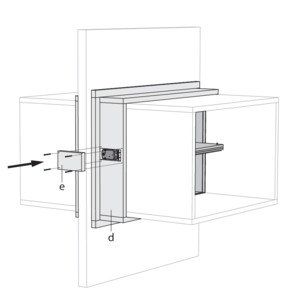
Provide a protected opening for access to the actuator.
Example (not exhaustive - see 1.): Promatect L500 ≥ 50 mm
Make an opening in the frame (d) of 230 x 110 mm. Make a cover plate (e) of 280 x 210 mm made of the same duct material to cover the actuator (fasten with 4 ø5x90 mm screws). Seal the opening around the power cables with a fire-resistant mastic (e.g. BMS).
Example (not exhaustive - see 1.): Promatect L500 ≥ 50 mm
Make an opening in the frame (d) of 230 x 110 mm. Make a cover plate (e) of 280 x 210 mm made of the same duct material to cover the actuator (fasten with 4 ø5x90 mm screws). Seal the opening around the power cables with a fire-resistant mastic (e.g. BMS).
General remarks
- The installation must comply with the installation manual and the classification report.
- The installation of the smoke control duct must comply with the classification report delivered by the manufacturer.
- Axis orientation: see the declaration of performance.
- Avoid the obstruction of adjoining smoke control ducts.
- Verify if the blade can move freely.
- Rf-t smoke dampers may be applied to smoke control ducts that have been tested according to EN 1366-8 and EN 1366-9 as appropriate.
- Caution: when fitting, the product should be handled with care and remain protected from any sealing products.
- Caution: before putting the installation into operation, clean off all the dust and dirt.
- Caution: bear in mind the blade’s clearance inside the smoke control duct.
 Open to innovation, closed to fire
back
Open to innovation, closed to fire
back

